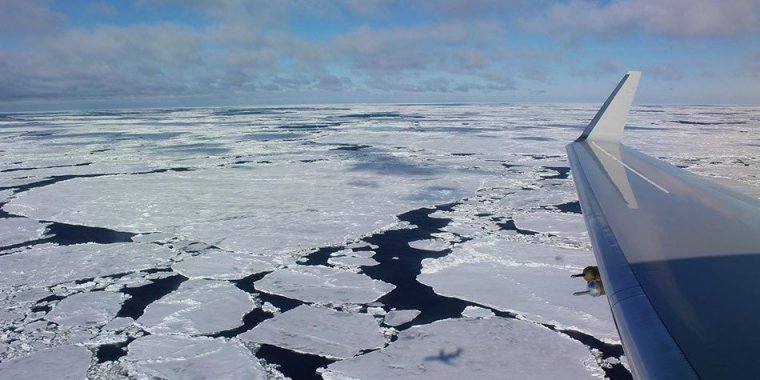| News / Science News |
Aircraft reveal surprisingly strong Southern Ocean carbon sink
The Southern Ocean is a significant carbon sink -- absorbing a large amount of the excess carbon dioxide emitted into the atmosphere by human activities -- according to a new study led by scientists affiliated with the National Center for Atmospheric Research.

The NSF/NCAR Gulfstream V casts a shadow on the marginal ice zone of the Southern Ocean. Photo: Rebecca Hornbrook/NCAR
The findings provide clarity about the role the icy waters surrounding Antarctica play in buffering the impact of increasing greenhouse gas emissions.
Previous research published in recent years suggested the Southern Ocean might be less of a sink than previously thought.
The study uses observations from research aircraft flown during three field projects over nearly a decade, as well as a collection of atmospheric models, to determine that the Southern Ocean takes up significantly more carbon than it releases.
The research also highlights the power that airborne observations have in revealing patterns in the global carbon cycle.
"You can't fool the atmosphere," said NCAR scientist Matthew Long, the paper's lead author.
"While measurements taken from the ocean surface and from land are important, they are too sparse to provide a reliable picture of air-sea carbon flux. The atmosphere, however, can integrate fluxes over large expanses. Airborne measurements show a drawdown of CO2 in the lower atmosphere over the Southern Ocean surface in summer, indicating carbon uptake by the ocean."
Once human-produced CO2 emissions from burning fossil fuels and other activities enter the atmosphere, some of the gas is taken up by plants and some is absorbed into the ocean.
While the overall concentration of CO2 in the atmosphere continues to increase, causing the global temperature to rise, these land and ocean "sinks" slow the effect.
A more precise understanding of where carbon sinks exist, how big they are, and how they may be changing as society continues to emit more CO2 is crucial to projecting the future trajectory of climate change.
It is also necessary for evaluating the impact of potential emission reduction measures and CO2 removal technologies.
The research team pieced together airborne measurements from three different field projects stretching over nearly a decade: the HIAPER Pole-to-Pole Observations, or HIPPO, project; the O2/N2 Ratio and CO2 Airborne Southern Ocean, or ORCAS, study; and the Atmospheric Tomography, or ATom, mission.
Data from the aircraft campaigns captured the vertical CO2 gradient. For example, during the ORCAS field campaign, scientists on board the NSF/NCAR HIAPER Gulfstream V research aircraft could see a decrease in CO2 concentrations on their instruments as the plane descended. (National Science Foundation)
YOU MAY ALSO LIKE





